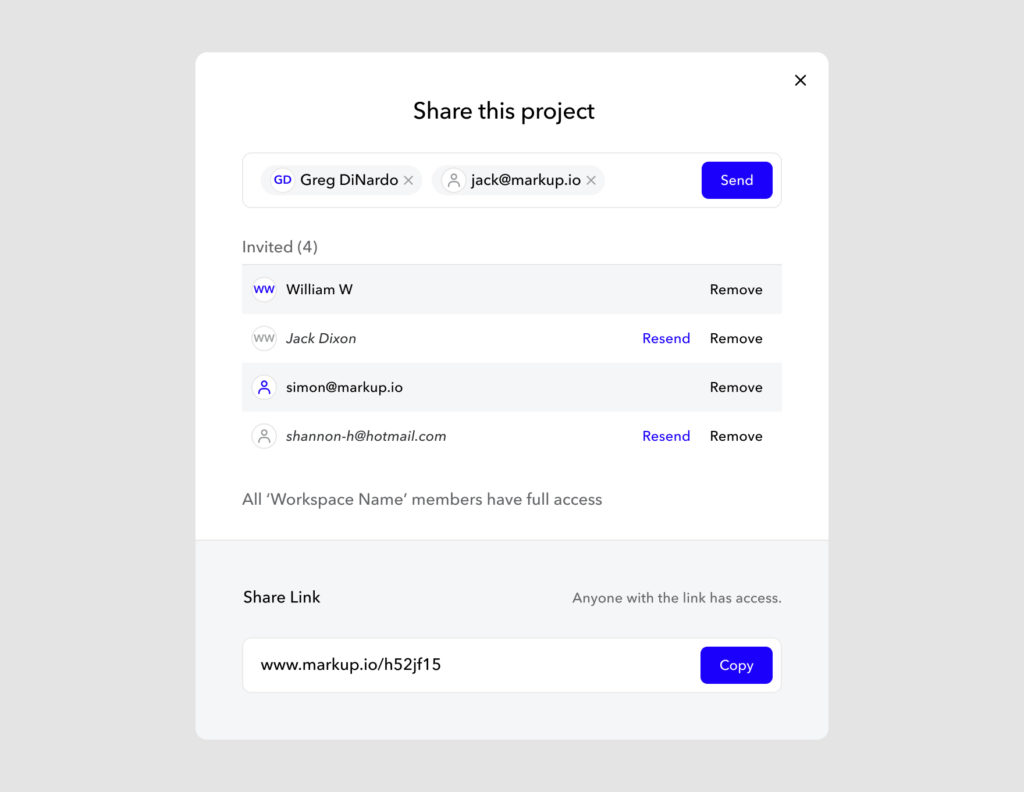The lengthy project you’ve been working on is finally coming to an end.
After implementing waves and waves of revision requests and edits, you’re proudly tagging your deliverable as “final draft.“
Now, all that’s left is for the stars and planets to align so the project passes the project approval stage with flying colors.
Fingers crossed!🤞
You keep your eyes on your inbox nervously and wish there was a way to have visibility into what management, clients, and stakeholders think of the final draft.
Spoiler alert: there is!
Project approval software can help you get projects signed off faster and hassle-free.
But before we talk about that, let’s go over some basics.
Table of contents
What is a project approval process?
A project approval process is a standardized procedure during which decision-makers ensure that projects, invoices, budgets, and other processes and deliverables that have a direct impact on the organization’s financial status, strategy, and reputation are up to par with the quality standards and requirements established by the organization.
The approval process is the last stage in project management and consists of the following processes:
- Deliverables reach the final draft stage
- Management, stakeholders, and/or clients perform a final review of creative collaterals
- Deliverables are either approved or reintroduced into the production loop
You can think of the project approval process as hosting a dinner party.
All the different types of people involved in a project have their own unique tastes and preferences, so what impacts one person positively might not even matter to another.
So, when it comes to bringing everyone together at the table to get approval from all stakeholders, you need to find a way to satisfy everyone.
Plus, you need to make the whole process frictionless and time-efficient.
Luckily, there’s an easy seven-step method you can follow to establish the smoothest project approval process possible.
#1: Specify your project approval requirements
The first thing you have to do to ensure your project approval workflow is bottleneck-free is pinpoint the most frequent project types your team works on that need approval from higher-ups.
Think in terms of file formats.
Are video editing projects part of your day-to-day? Then you will need a video annotation software solution to help you effortlessly submit your projects for review.
Figuring this out will give you a better idea of the project approval software to look for.
Next, try to identify the main issues standing between you and meeting project deadlines. Consider the following questions:
- Is it a lengthy project review process? (Hint: If so, you will need software that can help you streamline both the review and approval processes).
- Is it the long paragraphs of feedback that need decoding and hinder your productivity in the process?
- Is it the endless chains of disparate feedback provided over email?
If any of the above sounds like you, visual annotation software is something you need to consider.
The point is that when it comes to project approval, teams first need to specify the needs and requirements of their projects.
Doing so can help you make sure you’re taking the right steps to improve the whole operation—from the first to last draft and sign-off. This way, you won’t lose valuable time and money.
Plus, specifying project requirements allows you to choose a tool that will cover your unique business needs (that’s our next step!). 😉
#2: Choose a powerful project approval tool
Working with the right tool is essential to making the final approval step easier for everyone involved.
A capable project approval tool can help you drive time-saving efficiencies that can make your creative process up to 50% faster!

To make your decision-making process easier, we’re going to explore the main features of four of the best project approval tools out there.
Tool #1: MarkUp.io
Wow, we’re first on the list!
We’d like to thank our parents, our friends, our mentors… OK, fine, we’ll skip the speech.
All jokes aside, MarkUp.io is a leading visual commenting platform that helps creative professionals effortlessly optimize their project review and approval processes.
Moreover, MarkUp.io helps remote teams make collaboration frictionless and communication seamless through intuitive tools with a close-to-zero learning curve. 😊
Features
With MarkUp.io, you can create MarkUps of the most popular file types, including JPG, PNG, PDF, MP4, and MOV (find the full list here).
In addition to allowing you to create sharable copies of your projects and submit them for review and approval via shareable links, MarkUp.io features powerful capabilities like:
- Real-time MarkUp annotation
- Account-level permissions
- Email notifications
- Feedback archive
Who is MarkUp.io for?
MarkUp.io is the perfect tool for any team of professionals whose workflows include a proofing, review, and/or approval process.
What’s more, MarkUp.io’s functionality caters to the needs of any team size—from freelancers that need client approval to large enterprises that want to streamline internal processes.
Tool #2: Integrify
Integrify is another software platform you can use to automate and scale your project approval process.

Integrify helps users manage approvals through standardized project intake templates and routing that account for custom criteria and business rules.
Features
Integrify offers a wide range of features that can help users standardize their project approval processes, including:
- Low-code workflow automation (drag and drop)
- Task and project approval assignments
- Task-level collaboration
- Reminders and notifications
Who is it for?
According to Capterra, Integrify is best for medium-sized businesses, as well as large enterprises that need to increase workflow visibility and efficiency.
Integrify users rely on the platform to approve things like:
- Project schedules
- Project budgets
- Pricing structures
- Project plans
- Invoices
Tool #3: ProofHub
ProofHub is a project planning software solution that can help professionals simplify project management, deliver projects on time, and stay organized.

Specifically, the platform offers tools for project scope estimation, feedback, communication, and task management.
Features
In terms of project approval features, ProofHub provides:
- Custom project workflows and task sequencing
- Proofing tools for file review and collaboration
- Real-time reporting, metrics, and project insights
- Project request forms for easily accessible client work
Who is it for?
ProofHub is suitable for teams of any size, including freelancers and large corporations.
Tool #4: Filestage.io
Filestage is part of the annotation tool category. The platform helps teams make their approval process more organized and time-efficient.

Features
Filestage.io gives users the ability to establish a consistent approval process through features like:
- Records of project reviews
- Custom review steps and business process automation
- Annotation and feedback tools
- Content management
Who is it for?
Filestage is great for small teams, large organizations, and anything in between.
As you can probably already tell, not all project approval software solutions are created equal.
On one hand, we have proofing software, like MarkUp.io and Filestage.io, which can help you:
- Go from the initial draft to sign-off faster
- Request and provide feedback in real-time
- Keep project deliverables organized
On the other hand, project management and workflow automation software, like Integrify and ProofHub, can give your project team a more structured way of doing things from the project ideation stage to project approval.
It is important to note that these two categories are not mutually exclusive! For maximum results, you can use workflow automation in combination with annotation tools.
It all just comes down to mixing and matching to find the perfect fit for your needs.
#3: Keep stakeholders in the loop
Generally, collaboration tools help teams save time and make sure all team members are on the same page.
MarkUp.io is no different!
The platform features multiple communication tools that help you and your project team speak the same language.
For instance, MarkUp.io enables you to add contextual feedback to any element that needs to be edited.
This eliminates confusion and helps you reach the final draft stage faster without having to spend long hours straining your eyes while trying to figure out what the reviewer is referring to when providing email feedback.
Let’s assume you chose MarkUp.io as your go-to annotation tool for project approval. Now, let’s dive into a hands-on tutorial for sharing deliverables with your reviewers.
So, in this case, you are the submitter.
Before sharing your projects with the team, you have to create a MarkUp—a virtual copy of your project.
With MarkUp.io, you can create MarkUps of design files, documents, spreadsheets, images, and even live websites (Pro tip: if you have questions about how to annotate a website in a few simple steps, this guide is for you).
For MarkUps of anything but live webpages, you can simply drag and drop your files into your MarkUp.io workspace.

Once your MarkUp has been created, you can click anywhere inside it to leave notes before sharing it with your stakeholders.
#4: Share assets for review and approval
Next, share your MarkUp by clicking on the “Share” button at the bottom right corner of the page.
You can choose whether you’d like to share the MarkUp link yourself or if you’d prefer to send it over email.

Do you know what this means?
No need for email attachments. 🥳
#5: Share thoughts, comments, and feedback
Now, the wait begins.
Your reviewer receives the MarkUp link, and the approval process starts. Reviewers will ensure your deliverables meet the project requirements and live up to the company’s quality standards.
And, usually, you have no idea what’s going on with your draft until you receive an email from the reviewer.
But when using an approval tool, the approval process is different from what you’re used to. 😏
For example, with MarkUp.io, you have full visibility into the feedback process. Namely, the comments your reviewer makes are displayed on your end in real-time.

#6: Integrate feedback and resolve comments
The second to last step of the process is to implement feedback. 🙂
Resolve comments by hovering over the active comments on the left side of the screen and clicking on the green “Resolve” button.

If you accidentally resolve a comment that’s not implemented yet, you can go to the “Resolved” tab and click on the red “Unresolve” button.
Once you resolve all the comments, they will be permanently stored in the “Resolved” tab of each specific project MarkUp.
In other words, you’ll have a feedback archive for each MarkUp in your workspace.
#7: Finalize and approve
As soon as you’re done implementing the feedback you’ve received, you’re close to the finish line.
Now, you can create another MarkUp with the final version of your project and share it once again with your clients or managers.
Fingers crossed for a green light!
As you can see, when using a proofing tool as part of your approval workflow, things get easier.
You’re more likely to reach milestones faster, stay on top of due dates, and collaborate better with team members.
Are you ready to experience all this and more?
Over to you
It’s time to remove instant messaging from your project approval process for good and gain a competitive advantage with cutting-edge visual collaboration technology.
If this sounds like something you and your team would benefit from, give MarkUp.io a try.
Sign up with MarkUp.io and let back-and-forth feedback become a thing of the past!

